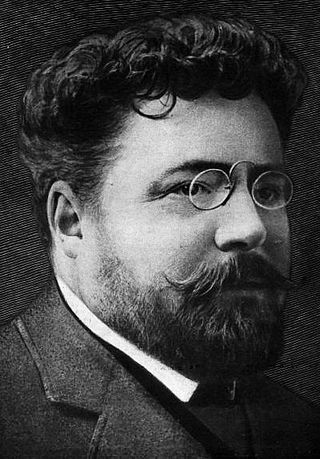
Gaston Louis Alfred Leroux was a French journalist and author of detective fiction.
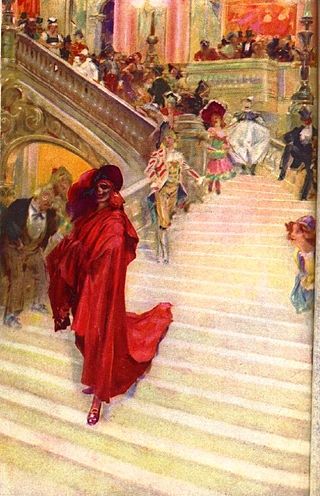
The Phantom of the Opera is a novel by French author Gaston Leroux. It was first published as a serial in Le Gaulois from 23 September 1909 to 8 January 1910, and was released in volume form in late March 1910 by Pierre Lafitte. The novel is partly inspired by historical events at the Paris Opera during the nineteenth century, and by an apocryphal tale concerning the use of a former ballet pupil's skeleton in Carl Maria von Weber's 1841 production of Der Freischütz. It has been successfully adapted into various stage and film adaptations, most notable of which are the 1925 film depiction featuring Lon Chaney, and Andrew Lloyd Webber's 1986 musical.

London After Midnight is a lost 1927 American silent mystery horror film directed and co-produced by Tod Browning and starring Lon Chaney, with Marceline Day, Conrad Nagel, Henry B. Walthall and Polly Moran. The film was distributed by Metro-Goldwyn-Mayer, and was written by Waldemar Young, based on the story "The Hypnotist" which was written by Browning. Merritt B. Gerstad was the cinematographer, and the sets were designed by Cedric Gibbons and Arnold Gillespie. Harry Sharrock was the assistant director. The film cost $151,666.14 to produce, and grossed $1,004,000. Chaney's real-life make-up case can be seen in the last scene of the film sitting on a table, the only time it ever appeared in a film.

Son of Dracula is a 1943 American horror film directed by Robert Siodmak with a screenplay based on an original story by his brother Curt Siodmak. The film stars Lon Chaney Jr., Louise Allbritton, Robert Paige, Evelyn Ankers, and Frank Craven. The film is set in the United States, where Count Alucard has just taken up residence. Katherine Caldwell (Allbritton), a student of the occult, becomes fascinated by Alucard and eventually marries him. Katherine begins to look and act strangely, leading her former romantic partner Frank Stanley (Paige) to suspect that something has happened to her. He gets help from Dr. Brewster (Craven) and psychologist Laszlo who come to the conclusion that Alucard is a vampire.

Murders in the Rue Morgue is a 1932 American horror film directed by Robert Florey, based on Edgar Allan Poe's 1841 short story "The Murders in the Rue Morgue". The plot is about Doctor Mirakle, a carnival sideshow entertainer and scientist who kidnaps Parisian women to mix their blood with that of his gorilla, Erik. As his experiments fail because of the quality of his victims' blood, Mirakle meets with Camille L'Espanye, and has her kidnapped and her mother murdered, leading to suspicion falling on Camille's fiance, Pierre Dupin, a medical student who has already become interested in the earlier murders.

Island of Lost Souls is a 1932 American science fiction horror film directed by Erle C. Kenton. Produced and distributed by Paramount Productions, it is based on H. G. Wells' 1896 novel The Island of Doctor Moreau, and stars Charles Laughton, Richard Arlen, and Kathleen Burke. Island of Lost Souls is about Edward Parker (Arlen), a sailor who finds himself stranded on an island that is occupied by the scientist Dr. Moreau (Laughton). Parker agrees to stay until the next boat arrives; Moreau introduces him to Lota (Burke), who unknown to Parker, is part-panther. It is revealed all of the island's inhabitants are the results of Moreau's experiments to create humans from animals. Moreau tries to persuade Lota to have sex with Parker so he can continue his experiments.

The Cat and the Canary is a 1927 American silent comedy horror film directed by Paul Leni. An adaptation of John Willard's 1922 black-comedy play of the same name, the film stars Laura La Plante as Annabelle West, Forrest Stanley as Charlie Wilder, and Creighton Hale as Paul Jones. The plot revolves around the death of Cyrus West, who is Annabelle, Charlie, and Paul's uncle, and the reading of his will twenty years later. Annabelle is revealed as the heir, but she and the other guests must still face a night in his haunted mansion. The plot thickens when they are informed that a lunatic known as the Cat has escaped from an asylum and is hiding in the house.

The Last Warning is a 1928 sound part-talkie American mystery film directed by Paul Leni, and starring Laura La Plante, Montagu Love, and Margaret Livingston. In addition to sequences with audible dialogue or talking sequences, the film features a synchronized musical score and sound effects along with English intertitles. The film apparently only survives in a cut-down edited silent version which was made for theaters that had not yet converted to sound. The soundtrack for the sound version, which was also released on sound-on-disc format, survives in private hands on Vitaphone type discs.
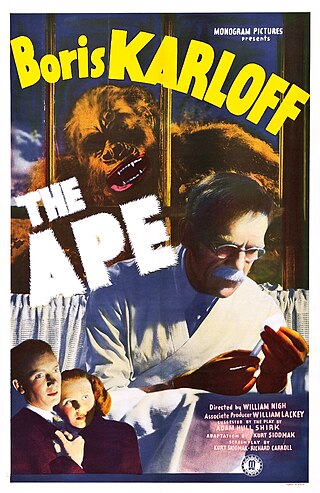
The Ape is a 1940 American horror film directed by William Nigh. The film is based on Adam Hull Shirk's play The Ape, which was previously adapted by Nigh as The House of Mystery (1934). The film stars Boris Karloff as Dr. Bernard Adrian who is seeking to cure a young woman's polio through experiments involving spinal fluid. Meanwhile, a vicious ape has been terrorising the towns locals, and breaking into Adrian's lab. A battle ensues between the two, leading to Adrian deciding to skin the ape and disguise himself as the beast in order to get more spinal fluid. His previous samples were destroyed in the battle.

A Blind Bargain is a lost 1922 American silent horror film starring Lon Chaney and Raymond McKee, released through Goldwyn Pictures. The film was directed by Wallace Worsley and is based on Barry Pain's 1897 novel The Octave of Claudius. Lon Chaney played a dual role in the film, as both Dr. Lamb and "the Ape Man", one of Chaney's few "true horror films". The claim that Wallace Beery appeared as an ape-man uncredited has never been proven, but does persist in many sources.

The Werewolf is a 1913 silent film short directed by Henry MacRae. The film is about a Navajo woman becoming a timberwolf.

The Ape Man is a 1943 American horror film directed by William Beaudine. The film is based on "They Creep in the Dark" by Karl Brown, which was published in The Saturday Evening Post. It stars Bela Lugosi as Dr. James Brewster who is aided by his colleague Dr. Randall. The doctor manages to transform himself into a ape man hybrid and desperately seeks a cure. Brewster believes that only the injection of human spinal fluid will prove effective as a cure. As Randall refuses to help him, Brewster and his captive gorilla seek involuntary donors.
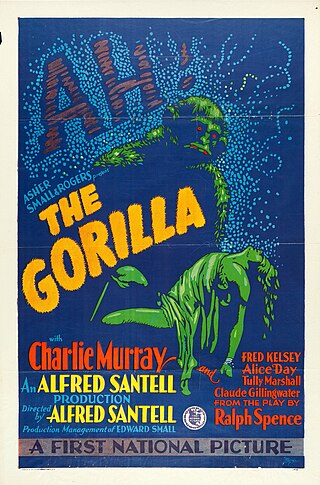
The Gorilla is an American 1927 silent mystery film directed by Alfred Santell based on the play The Gorilla by Ralph Spence. It stars Charles Murray, Fred Kelsey, and Walter Pidgeon.
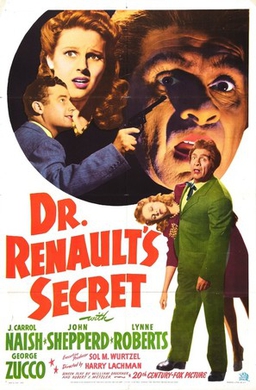
Dr. Renault's Secret is a 1942 American horror mystery film. The story was written by William Bruckner and Robert Metzler. It is loosely based on the 1911 novel Balaoo by Gaston Leroux. The production was directed by Harry Lachman and is a B movie with both mad scientist and monster themes.

The Brute Man is a 1946 American horror thriller film starring Rondo Hatton as the Creeper, a murderer seeking revenge against the people he holds responsible for the disfigurement of his face. Directed by Jean Yarbrough, the film features Tom Neal and Jan Wiley as a married pair of friends the Creeper blames for his deformities. Jane Adams also stars as a blind pianist for whom the Creeper tries to raise money for an operation to restore her vision. The film is a prequel to House of Horrors (1946).

King of the Jungle is a 1927 American adventure film serial directed by Webster Cullison. The film is considered to be lost; only a trailer remains.
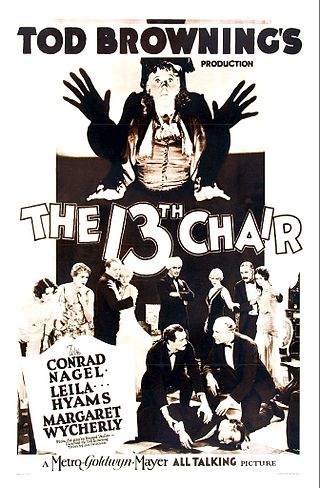
The Thirteenth Chair is a 1929 American mystery film directed by Tod Browning. The picture is based on a 1916 play of the same name by Bayard Veiller. It stars Conrad Nagel, Leila Hyams and Margaret Wycherly.

While London Sleeps is a 1926 Warner Bros. film about a police-dog, Rinty, who helps Scotland Yard defeat a dangerous criminal organisation known as the Mediterranean Brotherhood that operates out of the Limehouse district of London. While the film has no audible dialog, it was released with a synchronized musical score with sound effects using both the Vitaphone sound-on-disc process. Walter Morosco wrote the screenplay. It was the first of many films directed by Howard Bretherton, and one of several created for Rin Tin Tin, a German Shepherd dog used in films during the 1920s and 1930s. Only the sound discs to the film survive today with the visual film portions being lost. The British release prints censored the more horrific aspects of the film.

Seven Footprints to Satan is a sound part-talkie 1929 American mystery film directed by Danish filmmaker Benjamin Christensen. Based on the 1928 story of the same name by Abraham Merritt, it stars Thelma Todd, Creighton Hale, William V. Mong and Sheldon Lewis. In addition to sequences with audible dialogue or talking sequences, the film features a synchronized musical score and sound effects along with English intertitles. The film survives at the Cineteca Italiana in an alternate sound version known as an International Sound Version. The sound disks for this foreign sound version are apparently not extant.

The history of horror films was described by author Siegbert Solomon Prawer as difficult to read as a linear historical path, with the genre changing throughout the decades, based on the state of cinema, audience tastes and contemporary world events.




















